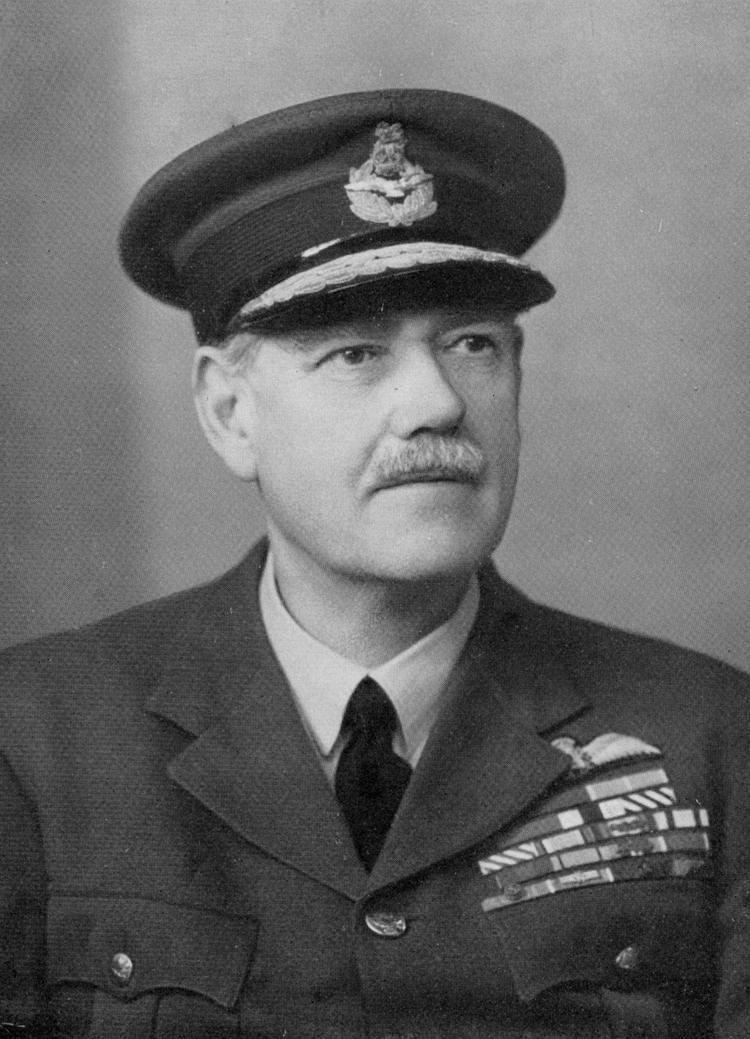Allegiance United Kingdom Rank Air marshal | Name Robert Saundby Years of service 1914–1946 | |
 | ||
Born 26 April 1896 ( 1896-04-26 ) Commands held Deputy Air Officer Commanding Battles/wars World War IWorld War II Awards Knight Commander of the Order of the BathKnight Commander of the Order of the British Empire - 1 January 1944Military CrossDistinguished Flying CrossAir Force CrossLegion of Honour, OfficerCommander of the Legion of MeritGrand Officer of the Order of Leopold II with PalmsCroix de Guerre 1940 with PalmsDeputy LieutenantFellow of the Royal Aeronautical Society Died September 25, 1971, Burghclere, United Kingdom Books Early aviation: man conquers the air | ||
Battles and wars World War I, World War II | ||
Air Marshal Sir Robert Henry Magnus Spencer Saundby (26 April 1896 – 25 September 1971) was an RAF officer whose career spanned both World War I and World War II. He distinguished himself gaining five victories during World War I, and was present during the air battle when Lanoe Hawker was shot down and killed by Manfred von Richthofen, the "Red Baron". He is chiefly remembered for his role as Deputy AOC in C Bomber Command under Sir Arthur 'Bomber' Harris during the latter part of World War II.
Contents
World War I
Robert Henry Magnus Spencer Saundby was born on 26 April 1896. He was the son of Professor Robert Saundby, and was born in Birmingham. He left school in 1913 and joined the Traffic Department of the London and North Western Railway. He joined the Royal Warwickshire Regiment, Territorial Force at the outbreak of war in 1914 as a private soldier. Upon completing officer training in June 1915, he spent time at the front line until January 1916 when he joined the Royal Flying Corps. He became a qualified pilot and joined Britain's first single-seater fighter squadron, No. 24 Squadron RFC, in its original complement under famous Major Lanoe Hawker VC, flying the Airco DH2 on the Western Front. His initial successes began on 31 July 1916; he drove down a Fokker Eindekker out of control, and was slightly wounded in the process.
Saundby transferred from 24 Squadron to 41 Squadron on 26 January 1917. On 4 March, while flying FE.8 Serial No. 6431, he shared a victory over an Albatros. Following this win, he transferred to Home Defense in Britain. By 1917 he was at Orford Ness RFC Experimental Station, England, and on 20 February 1917 he became a Flight Commander, No 11 Training Squadron RFC Scampton. He ended the war in this role.
On 17 June 1917 he was flying one of three aircraft, one of 37 Squadron RFC and two others from the Experimental Station that intercepted the Zeppelin L48 after she got lost trying to bomb London. As a result of their attacks, L48 crashed near Theberton. The victory was shared among the three air crews. Saundby not only became an ace with this win, he was awarded the Military Cross.
The Inter-War Years
Between 1919 and 1925, Robert Saundby moved slowly through the ranks of the newly formed RAF, whilst gaining experience of command. Between 1922 and 1925 he served as a Flight Commander in No. 45 Squadron, stationed in Iraq, flying the Vickers Vernon transport aircraft. He flew as co-pilot for the then Squadron Leader Arthur Harris, when the latter developed a locally improvised bombing capability for the Vernon
His move towards the upper command ranks of the RAF was initiated when he joined No. 58 Squadron as a Flight Commander on 15 October 1926 flying the Vickers Virginia at RAF Worthy Down. His Squadron Commander was Wing-Commander Arthur Harris, and the Squadron concentrated on developing night bombing techniques such as target-marking in their 70 mph machines. The other squadron at Worthy Down at the time, No. 7, was commanded by Wing-Commander Portal, later to become Chief of Air Staff during World War II and the direct superior and sometimes opponent of Harris.
After one year, Saundby attended RAF Staff College, Andover, and became an RAF Staff Officer, becoming Deputy Director of Operations in 1937.
World War II
By 1940, Saundby had become Senior Air Staff Officer (SASO), HQ Bomber Command. He served under Air Marshal Richard Peirse and then became Deputy AOC in C under Harris in 1943.
He was a supporter of the strategy of area bombing against German civil population and he very much became a right-hand man for Harris throughout the remainder of the war. On behalf of Harris he selected 94 German towns which were "fitted" for carpet bombing and gave codenames to each of them known as 'Fish code'; for example Nuremberg was codenamed Grayling and Berlin was Whitebait. It is thought that he chose this coding because he was a keen fly fisherman. He retired on medical grounds from the RAF on 22 March 1946.
He was awarded the Order of Leopold II with Palme and Croix de Guerre 1940 with Palme, Commander class for services in the liberation of Belgium.
Retirement
He devoted much of his retirement to his role as Vice-Chairman, Council of Territorial and Auxiliary Forces Association, for which he was awarded his KCB. He had many hobbies, and wrote several books on differing subjects including his role in the RAF during the war (Air Bombardment, The Story of its Development, How the Bomber and the Missile Brought the Third Dimension to Warfare) and Steam Engines (Early British Steam 1825-1925 The First 100 Years). He lived at Burghclere in Hampshire where he died on 25 September 1971.
